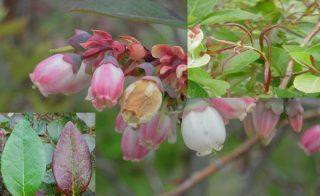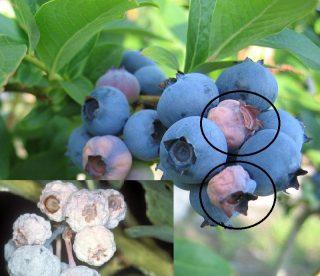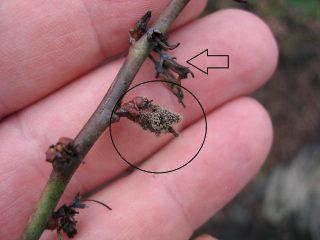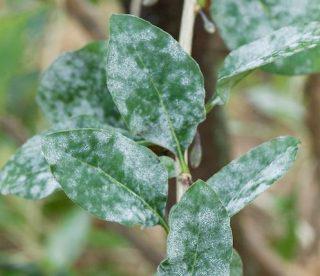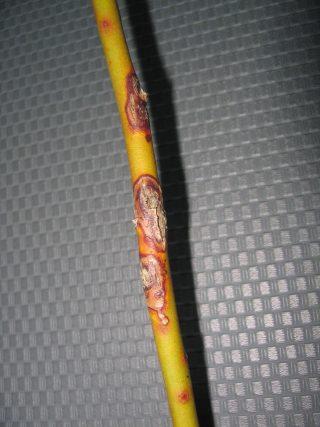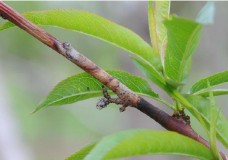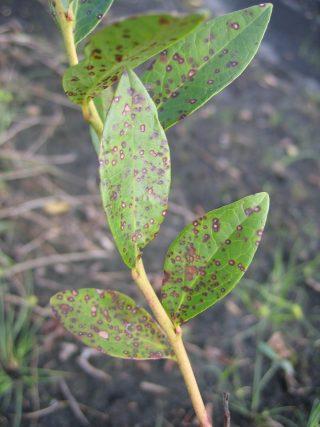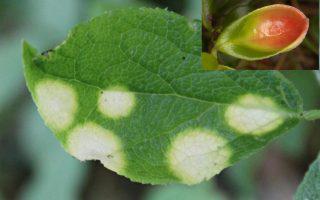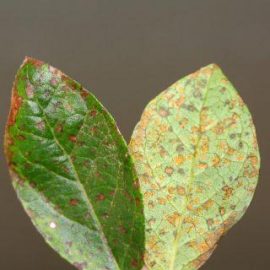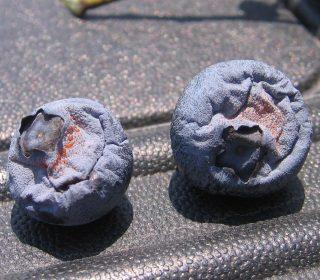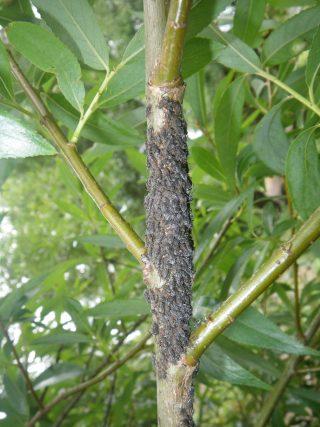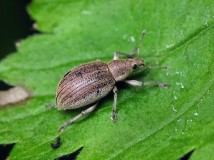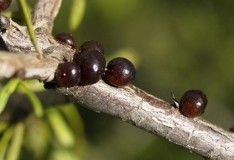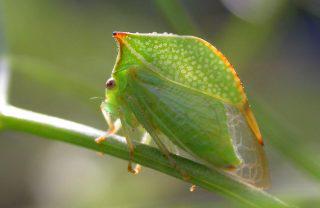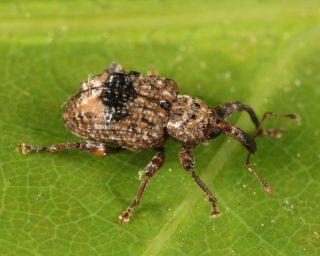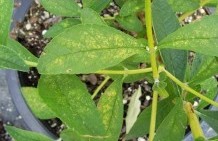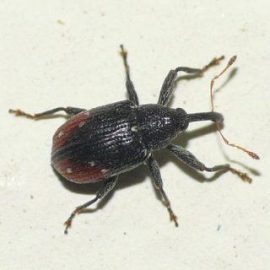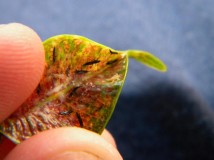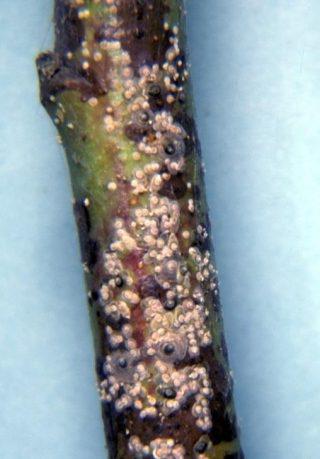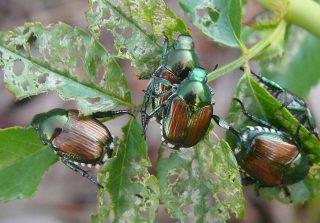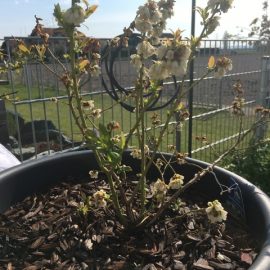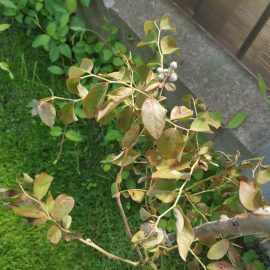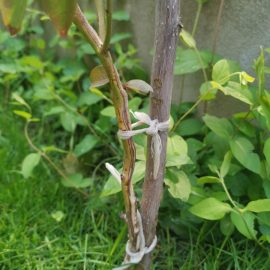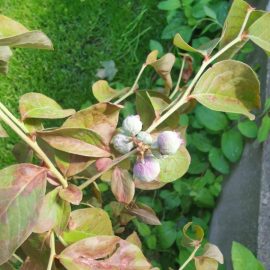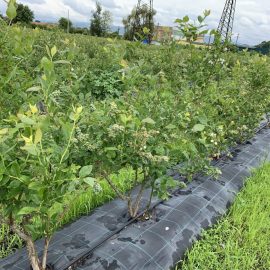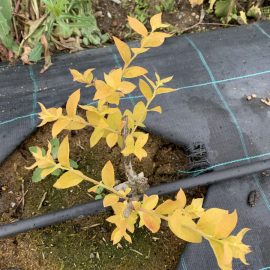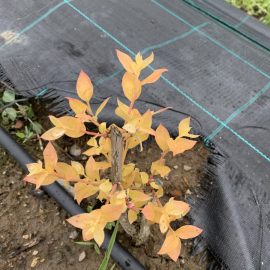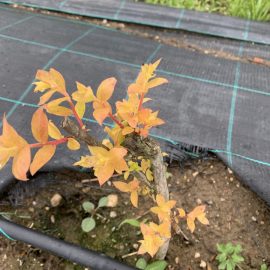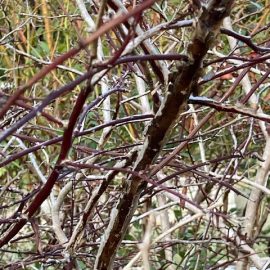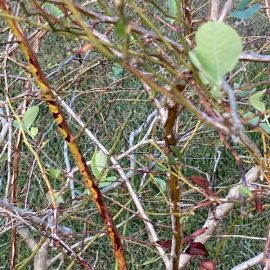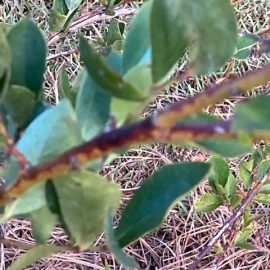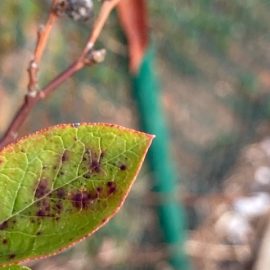Blueberry treatments, pest and disease control
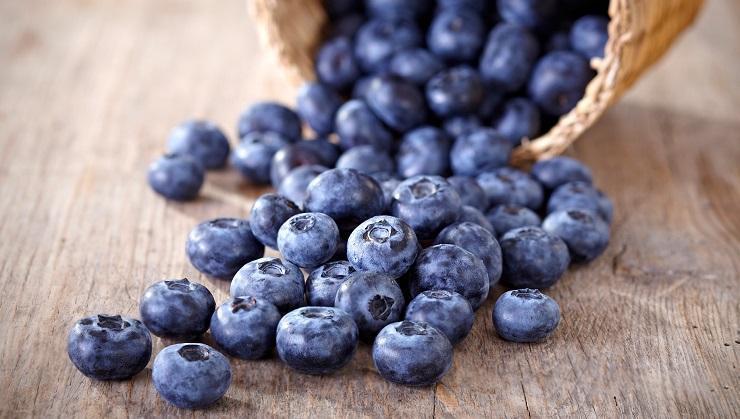
Blueberry (Vaccinium myrtillus) is a 30-60 cm high fruit-bearing shrub, generally widespread in mountainous areas. Its leaves are oval, small, and short-petiolate, while the flowers are bell-shaped, and of various colors. The fruit is a dark-blue, round, juicy berry, with a sweet and sour taste. One of the most important factors in blueberry cultivation is the soil, which should have good drainage and a pH between 4.2 and 4.8. Additionally, it should be rich in humus.
Besides the nourishing properties of the fruits, they, along with the leaves, also have medicinal purposes.
The main diseases of blueberry shrubs
Blueberry Shoestring Virus
The name of this virus comes from the symptoms it causes. The leaves of infected shrubs turn red and curve sharply downwards, appearing as a shoelace. The flowers become reddish and the fruit no longer has the specific blue colour. The characteristic symptom is reddish stripes on young or 1-year-old stems. Aphids transmit the virus.
Prevention and control measures:
- using certified planting material and resistant varieties;
- removing and destroying affected plants from the crop, as soon as they are observed;
- applying insecticides to keep the aphid population under control.
Mummy berry disease (Monilinia vaccinii-corymbosi)
The fungus attacks blueberry branches and flowers, it penetrates the flower ovary and grows with the fruit. After maturation, the fruits shrivel up, turn yellow, and fall off. The fungus spreads through spores and can also be transmitted by pollinating insects, which carry infected pollen.
Prevention and control measures:
- gathering and burning mummified fruits;
- chemical treatments with specific fungicides (in the bud opening phenophase).
Gray mold (Botrytis cinerea)
This disease can attack all the aerial organs of the plant, but the most common attack is on the inflorescences. They wilt, brown, and abort, while the fungus fructifications appear on their surface. The young stems and leaves wither suddenly and fade. Fruits are affected too, they also fade and rot. This disease is favored by high atmospheric humidity and can cause significant damage even after harvest.
Prevention and control measures:
- rational irrigation, preferably with drip systems;
- balanced fertilization;
- removing and burning affected organs;
- chemical treatments with specific fungicides.
Recommended products
-
You can find products on a different store
Change Store -
You can find products on a different store
Change Store -
You can find products on a different store
Change Store -
You can find products on a different store
Change Store -
You can find products on a different store
Change Store -
You can find products on a different store
Change Store -
You can find products on a different store
Change Store -
You can find products on a different store
Change Store -
You can find products on a different store
Change Store -
You can find products on a different store
Change Store -
You can find products on a different store
Change Store -
You can find products on a different store
Change Store -
You can find products on a different store
Change Store -
You can find products on a different store
Change Store -
You can find products on a different store
Change Store -
You can find products on a different store
Change Store -
You can find products on a different store
Change Store -
You can find products on a different store
Change Store -
You can find products on a different store
Change Store -
You can find products on a different store
Change Store -
You can find products on a different store
Change Store -
You can find products on a different store
Change Store -
You can find products on a different store
Change Store -
You can find products on a different store
Change Store
Powdery mildew (Erysiphe vaccinii)
The disease appears on leaves, young shoots, and fruits. White, mycelial-looking spots appear on the leaves. As the disease progresses, the spots merge and cover the whole leaf, the mycelium becomes powdery and the attacked tissues dry out. Fruits may show spots similar to those on leaves. As a result of the attack, the fruit cracks and rots.
Prevention and control measures:
- chemical treatments during the vegetative period, with specific fungicides.
Recommended products
-
You can find products on a different store
Change Store -
You can find products on a different store
Change Store -
You can find products on a different store
Change Store -
You can find products on a different store
Change Store -
You can find products on a different store
Change Store -
You can find products on a different store
Change Store -
You can find products on a different store
Change Store -
You can find products on a different store
Change Store -
You can find products on a different store
Change Store -
You can find products on a different store
Change Store -
You can find products on a different store
Change Store -
You can find products on a different store
Change Store -
You can find products on a different store
Change Store -
You can find products on a different store
Change Store -
You can find products on a different store
Change Store -
You can find products on a different store
Change Store -
You can find products on a different store
Change Store -
You can find products on a different store
Change Store -
You can find products on a different store
Change Store -
You can find products on a different store
Change Store -
You can find products on a different store
Change Store -
You can find products on a different store
Change Store -
You can find products on a different store
Change Store -
You can find products on a different store
Change Store
Cankers (Botryosphaeria corticis, Fusicoccum putrefaciens)
These fungi show similar symptoms. Reddish conical ridges appear on the one-year-old stems, which crack in the next year. The affected area turns gray and rots.
Prevention and control measures:
- removing affected shoots.
Phomopsis twig blight (Phomopsis vaccinii)
This disease is less common in blueberry crops, but it can occur in neglected plantations. The first symptoms appear on the branches as large, reddish spots and as the disease progresses, it covers the entire crown. After the attack, the leaves wither and turn brown. Proper maintenance reduces the frequency of the attack.
Prevention and control measures:
- removing and burning the affected branches.
Septoria leaf spot of blueberry (Septoria albopunctata)
The symptoms of this disease appear mainly on the leaves as numerous small brown spots surrounded by a purple halo. As the disease progresses, the center of the spots becomes whitish. Eventually, the attacked leaves fall off and drop prematurely.
Prevention and control measures:
- gathering and burning the attacked leaves;
- chemical treatments with specific fungicides.
Azalea leaf gall (Exobasidium vaccinii)
This disease can attack all aerial organs of the plant. In early summer, white spots may appear on the leaves, where the tissue becomes sunken. Most of the time the attack of this fungus is isolated. Attacked fruits show white areas that do not ripen, reducing their commercial value.
Prevention and control measures:
- growing resistant varieties.
Leaf rust of blueberry (Pucciniastrum myrtilli)
The first symptoms of this disease include chlorotic spots on the upper part of the leaves. As the disease progresses, orange pustules appear on the underside, and over time the pustules turn black. The most affected leaves are those at the base of the shrub.
Prevention and control measures:
- chemical treatments with specific fungicides.
Recommended products
-
You can find products on a different store
Change Store -
You can find products on a different store
Change Store -
You can find products on a different store
Change Store -
You can find products on a different store
Change Store -
You can find products on a different store
Change Store -
You can find products on a different store
Change Store -
You can find products on a different store
Change Store -
You can find products on a different store
Change Store -
You can find products on a different store
Change Store -
You can find products on a different store
Change Store -
You can find products on a different store
Change Store -
You can find products on a different store
Change Store -
You can find products on a different store
Change Store -
You can find products on a different store
Change Store -
You can find products on a different store
Change Store -
You can find products on a different store
Change Store -
You can find products on a different store
Change Store -
You can find products on a different store
Change Store -
You can find products on a different store
Change Store -
You can find products on a different store
Change Store -
You can find products on a different store
Change Store -
You can find products on a different store
Change Store -
You can find products on a different store
Change Store -
You can find products on a different store
Change Store
Anthracnose (Colletotrichum gloeosporioides)
This fungus attacks all aerial organs of the shrub. On young shoots appear brown lesions. On their surface, the fungus fructifications appear as concentric, specific rings. Similar spots to those on the shoots develop on the leaves and the flowers abort as a result of the attack. On the fruits, symptoms occur only in the ripening phase. The disease progresses and the fungus fructifications develop as orange circular formations on the surface of the spots.
Prevention and control measures:
- chemical treatments with specific fungicides.
The main pests of blueberry shrubs
Aphids
Aphids are polyphagous species that migrate from one plant to another or from one species to another. They grow on wild flora and then move to cultivated species. They can be found as colonies on the underside of leaves, flowers or inflorescences, and young shoots. Attacked plants stagnate, turn yellow, and become susceptible to fungal attack. After feeding on plant sap, the aphids cover the leaves with their sweet droppings, forming the so-called “honeydew”, which allows saprophytic fungi to settle and form sooty mold.
Control methods:
- chemical treatments with specific insecticides.
Recommended products
-
You can find products on a different store
Change Store -
You can find products on a different store
Change Store -
You can find products on a different store
Change Store -
You can find products on a different store
Change Store -
You can find products on a different store
Change Store -
You can find products on a different store
Change Store -
You can find products on a different store
Change Store -
You can find products on a different store
Change Store -
You can find products on a different store
Change Store -
You can find products on a different store
Change Store -
You can find products on a different store
Change Store -
You can find products on a different store
Change Store -
You can find products on a different store
Change Store -
You can find products on a different store
Change Store -
You can find products on a different store
Change Store -
You can find products on a different store
Change Store -
You can find products on a different store
Change Store -
You can find products on a different store
Change Store -
You can find products on a different store
Change Store -
You can find products on a different store
Change Store -
You can find products on a different store
Change Store -
You can find products on a different store
Change Store -
You can find products on a different store
Change Store -
You can find products on a different store
Change Store
Sciaphobus squalidus
It is a dangerous species that attacks mainly the buds and flowering shoots of blueberry plants. It develops one generation every two years and overwinters as an adult in the topsoil. In spring, the adults emerge and feed on the buds and flower buds. The larvae are not harmful to the blueberry, they feed on the roots of spontaneous herbaceous plants.
Control methods:
- mobilizing the soil in the orchard in autumn.
Plum scale (Sphaerolecanium prunastri)
It is a polyphagous species, attacking several fruit trees, shrubs, vines, etc. It develops one generation per year and overwinters as a larva on the bark of attacked branches. Adults and larvae colonize shoots and leaves, causing tissue necrosis. They can also attack leaves, causing them to deform and fall off. Attacked plants are covered with the sweet droppings of these pests, which favor the appearance of phytopathogenic fungi.
Control methods:
- chemical treatments with specific insecticides.
Recommended products
-
You can find products on a different store
Change Store -
You can find products on a different store
Change Store -
You can find products on a different store
Change Store -
You can find products on a different store
Change Store -
You can find products on a different store
Change Store -
You can find products on a different store
Change Store -
You can find products on a different store
Change Store -
You can find products on a different store
Change Store -
You can find products on a different store
Change Store -
You can find products on a different store
Change Store -
You can find products on a different store
Change Store -
You can find products on a different store
Change Store -
You can find products on a different store
Change Store -
You can find products on a different store
Change Store -
You can find products on a different store
Change Store -
You can find products on a different store
Change Store -
You can find products on a different store
Change Store -
You can find products on a different store
Change Store -
You can find products on a different store
Change Store -
You can find products on a different store
Change Store -
You can find products on a different store
Change Store -
You can find products on a different store
Change Store -
You can find products on a different store
Change Store -
You can find products on a different store
Change Store
Buffalo treehopper (Cerasa bubalus)
It is a species that causes damage indirectly. It develops one generation per year and overwinters in the egg stage in the tree bark cracks. This treehopper feeds on the sap of herbaceous plants (clover, alfalfa, etc.). The females lay their eggs on the tree branches, in an incision made with the ovipositor, then the bark cracks in the affected area, and sap flow is stopped. Attacked branches no longer bear fruit normally, and in strong attacks, they wither. Also, the wounds produced are entry points for other pathogens. The greatest damage is to young plants, which wither after the attack.
Control methods:
Controlling this insect is difficult and requires preventive methods.
- carefully checking the planting material;
- cutting and burning the affected branches;
- controlling weeds;
- treatments with horticultural oil (during the dormancy period).
Plum curculio (Conotrachelus nenuphar)
This insect overwinters as an adult in the topsoil. First-generation larvae feed on the young fruits’ pulp and second-generation larvae feed on the shrub’s leaves.
Control methods:
- Specific insecticide treatments.
Mites
They are polyphagous insects, which are very difficult to see with the naked eye. They feed on the plant’s leaf sap and after the attack, the leaves look parchment-like, the flowers abort and the shrub stagnates in growth.
Control methods:
- chemical treatments with specific acaricides.
Recommended products
-
You can find products on a different store
Change Store -
You can find products on a different store
Change Store -
You can find products on a different store
Change Store -
You can find products on a different store
Change Store -
You can find products on a different store
Change Store -
You can find products on a different store
Change Store -
You can find products on a different store
Change Store -
You can find products on a different store
Change Store -
You can find products on a different store
Change Store -
You can find products on a different store
Change Store -
You can find products on a different store
Change Store -
You can find products on a different store
Change Store -
You can find products on a different store
Change Store -
You can find products on a different store
Change Store -
You can find products on a different store
Change Store -
You can find products on a different store
Change Store -
You can find products on a different store
Change Store -
You can find products on a different store
Change Store -
You can find products on a different store
Change Store -
You can find products on a different store
Change Store -
You can find products on a different store
Change Store -
You can find products on a different store
Change Store -
You can find products on a different store
Change Store -
You can find products on a different store
Change Store
Cranberry weevil (Anthonomus musculus)
It is a small, reddish insect that overwinters as an adult in the topsoil. In spring it emerges from its shelter and lays its eggs at the base of shoots. The larvae feed on the flowers, which do not open, wither, and drop.
Control methods:
- chemical treatments with specific insecticides (in the bud-opening phenophase).
Thrips
They are small insects, difficult to see with the naked eye. Thrips attack a large number of cultivated plants and fruit trees. They colonize the tops of the shoots, the flowers, and the leaves, causing flower abortion and growth stagnation.
Control methods:
- chemical treatments with specific insecticides;
- using sticky traps.
The San Jose scale (Quadraspidiorus perniciosus)
It is a polyphagous species, attacking more than 200 plant species. It has 1-3 generations per year and overwinters as larvae on the affected species’ bark. Females and larvae spread to all organs of affected plants, including the fruit, and feed on host plant sap. In a massive attack, the shields protecting the insect bodies overlap and suffocate the shrubs. They stagnate in growth, and after 2-3 years they wither.
Control methods:
- chemical treatments with specific insecticides (in the dormancy period).
Recommended products
-
You can find products on a different store
Change Store -
You can find products on a different store
Change Store -
You can find products on a different store
Change Store -
You can find products on a different store
Change Store -
You can find products on a different store
Change Store -
You can find products on a different store
Change Store -
You can find products on a different store
Change Store -
You can find products on a different store
Change Store -
You can find products on a different store
Change Store -
You can find products on a different store
Change Store -
You can find products on a different store
Change Store -
You can find products on a different store
Change Store -
You can find products on a different store
Change Store -
You can find products on a different store
Change Store -
You can find products on a different store
Change Store -
You can find products on a different store
Change Store -
You can find products on a different store
Change Store -
You can find products on a different store
Change Store -
You can find products on a different store
Change Store -
You can find products on a different store
Change Store -
You can find products on a different store
Change Store -
You can find products on a different store
Change Store -
You can find products on a different store
Change Store -
You can find products on a different store
Change Store
The Japanese beetle (Popillia japonica)
It develops one generation every 1-2 years and overwinters as a larva in the topsoil. It is a polyphagous species, attacking more than 300 plant species. Adults attack the leaves and flowers of shrubs, skeletonizing the leaves and consuming the plant organs. In case of a severe attack, it negatively affects production.














































































































































































































































































































































































































































